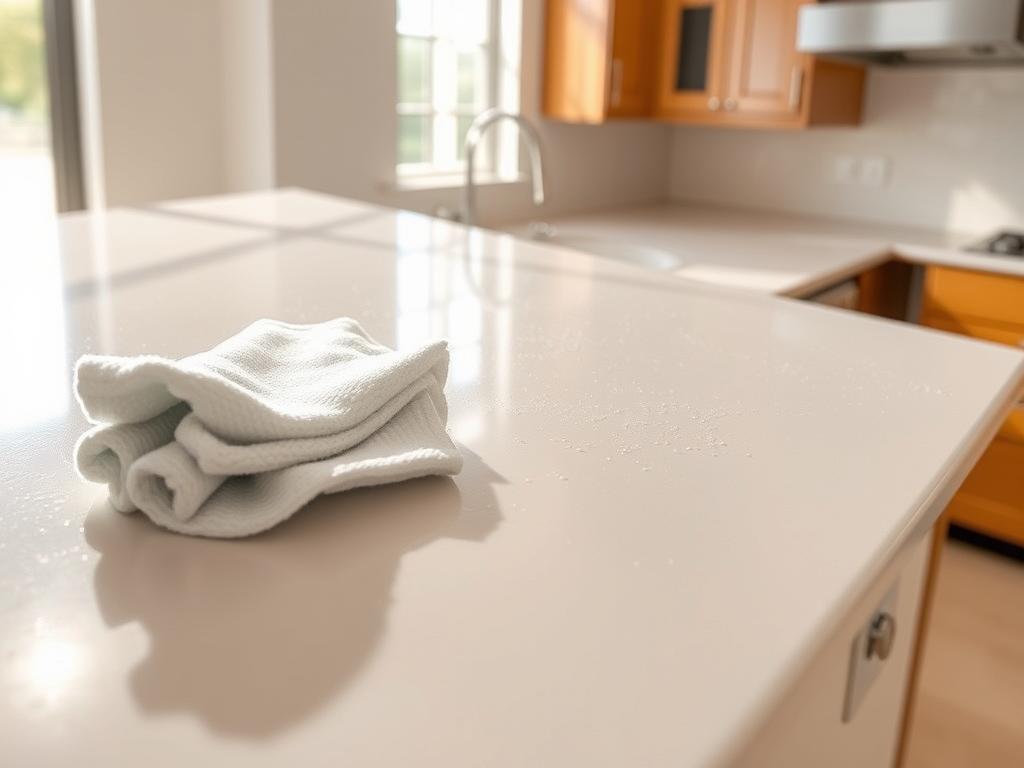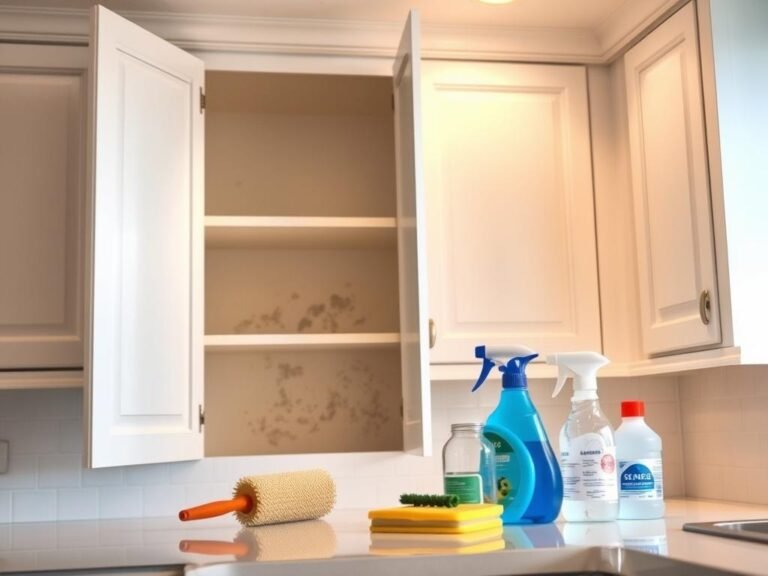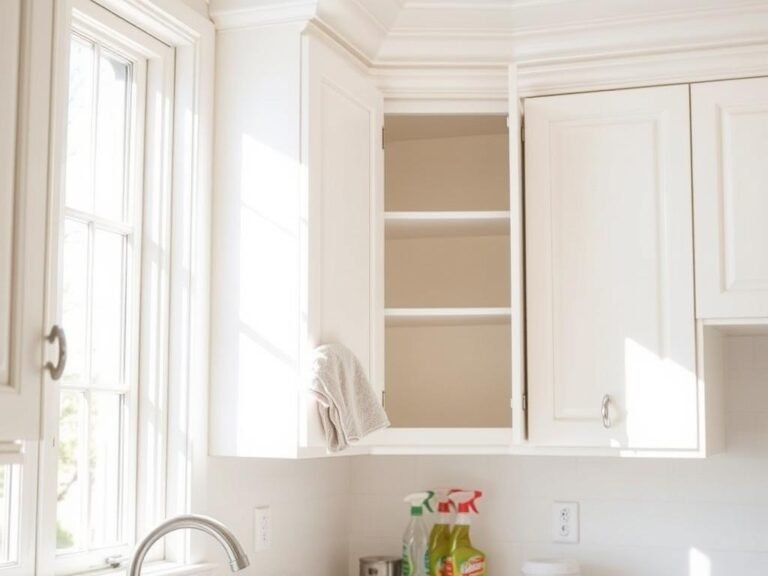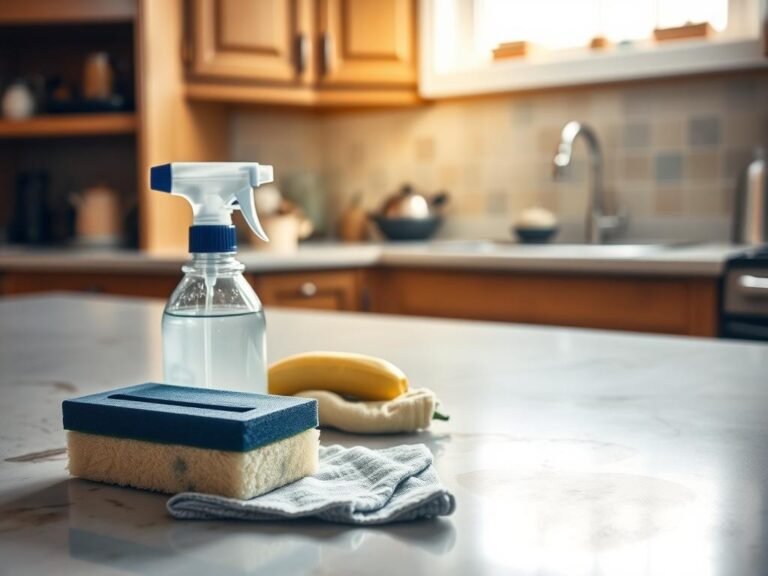Did you know that nearly 100% of homeowners have experienced damage to their cabinets without realizing it1? Lacquered kitchen cabinets, whether matt or glossy, require special care to maintain their attractive finish. Immediate attention to stubborn stains is crucial to prevent long-term damage2.
Using the right technique and gentle products is essential to protect both the cabinet and the wood underneath. A soft, microfiber cloth moistened with warm water and mild soap is recommended for maintenance3. Avoid aggressive detergents and products containing acetone, chlorine, or ammonia, as they can harm the finish.
The process involves common household items and a careful approach. Regular inspections and timely cleaning can prevent damage, ensuring your cabinets remain in great condition for years.
Key Takeaways
- Use a microfiber cloth with warm water and mild soap for regular cleaning.
- Avoid harsh chemicals like acetone, chlorine, and ammonia.
- Address stubborn stains immediately to prevent damage.
- Regular inspections can help maintain your cabinets’ condition.
- Keep cleaning products gentle to protect the finish and wood.
Preparation: Gathering Your Cleaning Essentials
Before you start cleaning your lacquered kitchen cabinets, it’s essential to gather the right tools and materials. This step ensures that you can clean effectively without damaging the finish or the wood underneath.
Choosing the Right Tools and Materials
A soft, microfiber cloth is your best friend when it comes to cleaning delicate surfaces. These cloths are gentle and won’t scratch the finish. For cleaning solutions, a mixture of warm water and mild soap or white vinegar is recommended. Avoid harsh chemicals like ammonia or chlorine, as they can harm the finish4.
Another important tool is a toothbrush for getting into tight spaces and cleaning hardware. A small, soft-bristled brush can help remove grease and food particles from corners and crevices5.
Selecting Safe Cleaning Products
When selecting cleaning products, always check the care instructions for your specific cabinet finish. Some products, even if gentle, might not be suitable for certain types of lacquer. It’s also a good idea to test any cleaning solution on a small, inconspicuous area first4.
For tough stains, a mixture of equal parts olive oil and white vinegar can be effective. Apply this solution gently with a soft cloth to avoid damaging the surface5.
| Tool/Material | Purpose | Recommended Use |
|---|---|---|
| Microfiber Cloth | Gentle cleaning of surfaces | Dampen with warm water and mild soap |
| White Vinegar | Removing grease and stains | Mix with water for a gentle solution |
| Toothbrush | Cleaning tight spaces and hardware | Dip in cleaning solution and scrub gently |
Having all your materials ready before you start cleaning ensures a smooth process without interruptions. Remember to always follow the manufacturer’s instructions for any cleaning product you use.
How to Clean Lacquered Kitchen Cabinets
Keeping your lacquered kitchen cabinets looking their best requires careful attention and the right techniques. Lacquered surfaces are delicate and can easily be damaged by harsh chemicals or rough cleaning methods. By following a few simple steps, you can maintain the attractive finish of your cabinets and ensure they remain in great condition for years to come.
Precautions When Working with Lacquered Surfaces
When it comes to cleaning lacquered surfaces, it’s essential to take extra precautions to avoid damaging the finish. Avoid using abrasive sponges or detergents, as they can scratch or dull the surface. Instead, use a soft, microfiber cloth that has been slightly dampened with warm water. This gentle approach will help protect the finish and prevent any unintended damage6.
Another important precaution is to avoid exposing the lacquer to chemicals like ammonia or chlorine. These substances can weaken the finish and cause it to become discolored or brittle over time. If you must use a cleaning product, make sure it’s specifically designed for use on lacquered surfaces and follow the manufacturer’s instructions carefully7.
It’s also crucial to test any cleaning solution on a small, inconspicuous area of the cabinet before applying it to the entire surface. This will help ensure that the solution doesn’t cause any discoloration or damage to the finish1.

| Tool/Material | Purpose | Recommended Use |
|---|---|---|
| Microfiber Cloth | Gentle cleaning of surfaces | Dampen with warm water and mild soap |
| White Vinegar | Removing grease and stains | Mix with water for a gentle solution |
| Soft-Bristled Toothbrush | Cleaning tight spaces and hardware | Dip in cleaning solution and scrub gently |
By following these precautions and using the right tools, you can keep your lacquered kitchen cabinets looking like new for years to come. Remember to always be gentle and avoid using harsh chemicals or abrasive materials that could damage the finish.
Step-by-Step Cleaning Process for My Cabinets
Keeping your cabinets in pristine condition requires more than just a quick wipe-down. A methodical approach ensures the finish stays vibrant and the wood remains healthy. By following these steps, you can maintain your cabinets’ appearance and longevity.
Removing Stubborn Stains and Grease
A soft cloth dampened with warm, soapy water is effective for tackling grease and stubborn stains2. For particularly tough spots, a mixture of linseed oil turpentine and flour can be used, as suggested by Casavogue. Gently scrub the area to avoid damaging the finish.
Proper Drying and Polishing Techniques
After cleaning, rinse the surface with warm water and immediately dry it with a microfiber cloth to prevent water spots. For polishing, a solution of equal parts white vinegar and water can be used to achieve a streak-free shine8. This step ensures the surface remains polished and protected.
Additional Tips for Maintaining a Shiny Finish
Regular maintenance is key. Clean the exterior every 1-2 weeks and the hardware with a vinegar and water solution to maintain appearance and prevent pest issues8. Avoid placing hot or humid objects on the surface to prevent damage. For spot treatments, a weekly check can help catch issues early.
- Use a microfiber cloth for gentle cleaning and drying.
- Apply a vinegar solution for polishing and maintaining shine.
- Regular inspections help in early detection of stains and damage.

By following these steps, your cabinets will retain their shine and remain in great condition for years. Proper cleaning not only enhances appearance but also protects the wood, ensuring your kitchen remains a focal point of your home.
Conclusion
Protecting your investment in lacquered surfaces requires careful attention to detail and the right techniques. By following the steps outlined, you can maintain the vibrant finish and ensure longevity of your cabinets.
A key takeaway is to always use a microfiber cloth dampened with warm water and mild soap for regular maintenance9. Avoid harsh chemicals that can damage the finish, and consider using a vinegar and water solution for polishing to achieve a streak-free shine10.
Regular inspections are crucial to catch stains and damage early. This simple habit can prevent major issues and keep your cabinets looking their best for years. Remember, consistent cleaning and timely touch-ups are essential for maintaining both appearance and durability.
By adopting these practices, you’ll not only protect your cabinets but also enhance your kitchen’s overall appeal. Take a moment to reflect on your current cleaning routine and consider any adjustments that could improve the care of your lacquered surfaces.




